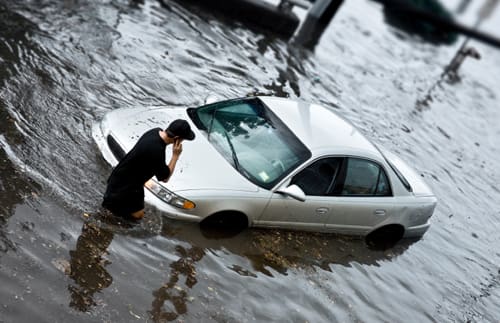Sometimes big problems could happen unexpectedly. We often hear how inadvertently drive their car into a big pool of invisible floodwater. The hot engine could be cracked by the thermal shock due to sudden exposure with the cold water. This can become a highly expensive mistake. Sudden temperature changes could also cause damages on catalytic converters. There are a number of precautions that we need to take when this happens. As an example, we could put the car into the second gear, while revving up the engine to prevent the exhaust from sucking in water. Eventually, the water can be deep enough that our car floats. If we are lucky, the current may flow to the direction we are travelling and we regain control of the car.

In general, we shouldn’t be overly optimistic when we drive into a flooded road, thinking that it’s shallow enough for our cars to cross. In many cases, the flood is too deep for our cars. When the road is flooded and the colors of the road is no longer visible, it is a good idea to pull over and inspect the situation. It is better to wait for awhile to see how other drivers respond to this situation. If other cars are able to safely plough to the road then we may also be able to do the same. However, if our car is too low, it is possible that cold water enters the hood compartments, damaging many components inside the car. This should be a simple precaution and we shouldn’t risk damaging our low-slung, much loved cars.
When we do want to cross the flooded road, we should choose the shallowest side and we should be able to spot it when we pull over the car before crossing. In this situation, we should exercise patience and use common sense. Unfortunately, despite our best efforts, it’s still possible that our car is flooded. A sudden flash flood could inundate the surrounding area, leaving us no opportunity to escape. If you car is flooded, there are many factors to consider. River water, mains water, sea water and sewer water have different characteristics. Some can be more damaging than the others. In general, we should make sure that we have undergone the necessary decontamination, cleaning and drying stages. The same things that apply to our house can be implemented to our cars.
The actual cost of repair could depend on the complexity of the car and the level of contamination. When we perform the task, we should make sure that the whole process is cost effective. As an example, sea water could cause irreversible damages, due to extensive corrosion in a very short time. Salt is highly corrosive, especially combined with humidity and oxygen. In the case of tsunami, flooded cars can be very expensive to repair. Regardless of the situation, we shouldn’t delay. It is important to look for ways to drain the car and make it dry faster by opening the doors and hood.


